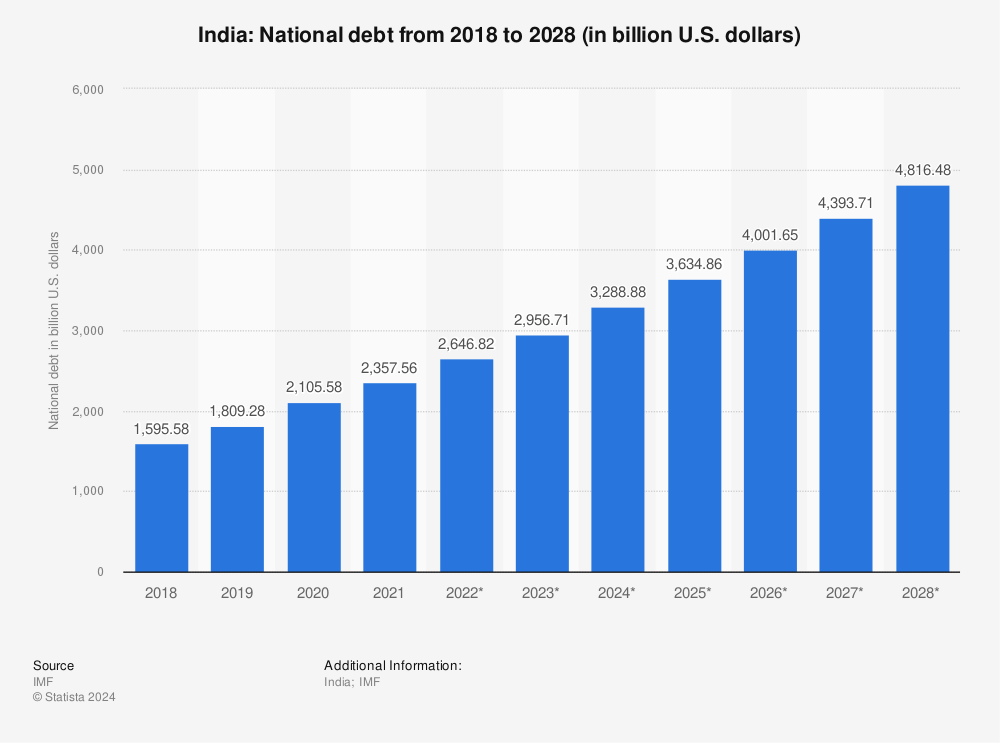 |
| Ninth Edition of the Status Paper on the Government Debt |
the Central Government released the Ninth Edition of the Status Paper on the Government Debt.
• It contains Debt Management Strategy (DMS) of the Central Government for the financial years from 2019-20 to 2021-22 which guides the borrowing plan of the Government.
• The objective of the DMS is to ensure that the government's financing requirementsand payment obligations are met at the lowest possible cost.
Significance of managing Government debt
The level of Government debt affects investor confidence, impacts fiscal capabilities of the government, leads to crowding out effect on private sector, fiscal repression of commercial banks alongside other impacts like inflationary pressure, exchange rate risk and higher taxes in the future.Important Terms:
Debt to GDP ratio
The debt-to-GDP ratio is the ratio of a country's debt to its gross domestic product
(GDP). It indicates a particular country’s ability to pay back its debts.Roll over risk
It is a risk associated with the refinancing of debt—specifically, that the interest chargedfor a new loan will be higher than that on the old. Generally, greater the shorter-term
maturing debt, greater the borrower's rollover risk.Currency or foreign exchange risk
It relates to vulnerability of the debt portfolio to depreciation in the value of the
domestic currency vis-à-vis the currency of denomination of external loans and the
associated increase in the Government's debt servicing cost.Interest payment to revenue receipts (IP-RR)
It is the ratio of total interest payments made towards the debt to the revenue receipts
of the government.Floating Rate Bonds (FRBs)
These are securities issued at variable coupon rates.Gross fiscal deficit (GFD)
It is the excess of total expenditure (including loans net of recovery) over revenue
receipts (including external grants) and non-debt capital receipts.Short-term debt
Short-term debt of the Central Government refers to the total amount of debt maturing
within the next 12 months.
• It includes 14-day intermediate treasury bills, regular treasury bills, dated securities
maturing in the ensuing one year and external debt with remaining maturity of less
than one year.Treasury bills
These are discounted instruments which help the Government in managing its short-
term cash flow mismatches.
• Central Government currently issues treasury bills of tenor of 91, 182, and 364 days.14-day IntermediateTreasury Bills (ITBs)
These are non-marketable instruments issued to the State Governments (and select
Central Banks) to enable them to deploy their short-term surplus cash at a fixed interest
rate.
Approach of the Central Government towards sustainable debt management
• Dedicated agency to manage debt: Government has decided to set up a statutory Public DebtManagement Agency (PDMA) to bring both, India's external and domestic debt under one roof.
o The first step towards this direction was the establishment of a Public Debt Management Cell (PDMC) as an advisory body within Budget Division, Ministry of Finance in 2016.
Government’s Medium-Term Debt Management Strategy (2019-2022):
Several steps will be taken by the government under it based on three broad pillars viz.,
Low cost of borrowing-
✔ Elongating maturity profile of the debt portfolio.
✔ Rationalization of interest rates on small savings schemes and other instruments like PF, special securities, etc.
✔ Advising other Divisions of Department of Economic Affairs with a view to help them arrive at the best terms for external loans.
Risk mitigation-
✔ Setting benchmarks for certain indicators such as external debt, to ensure minimal risk in terms of Roll-over Risk.
Market development-
✔ Maintaining transparency in the market borrowing programme, conducting regular investor interaction with stakeholders and issuing a variety of instruments to help investors manage their portfolio more efficiently.
✔ Creating benchmarks of desired tenors to enhance investor participation and liquidity.
✔ Supporting development of domestic investor base and calibrated opening of the Government securities market to foreign investors.
✔ Creating benchmarks of desired tenors to enhance investor participation and liquidity.
✔ Supporting development of domestic investor base and calibrated opening of the Government securities market to foreign investors.
India’s performance on indicators of debt sustainability
According to the status paper, Government’s debt portfolio is characterized by favorable sustainability indicators:• Gross Fiscal Deficit (GFD) as a percentage of GDP has been on a declining trend since 2012-13.
• The share of short-term debt is within safe limits and has stabilized after some rise during 2005 to 2012.
• The Government has adopted a conscious strategy of elongating maturity to reduce roll-over risk.
• Most of the Government debt is at fixed interest rates, with floating internal debt constituting only 0.9 per cent
of GDP in 2019, which minimizes the impact of interest rate volatility on the budget.
• Low share of external debt implies that currency risk and the susceptibility of debt portfolio to volatile
international capital markets is not substantial.
State Government Debt
• The debt-GDP ratio of States has marginally decreased in 2018-19 from 2017-18.• The share of public debt increased within the overall debt portfolio of the State Governments and constituted 19.1 per cent of their GDP.
• Within the public debt, the share of market borrowings increased while that of borrowings from the National Small Savings Fund (NSSF) exhibited a steady decline.
• Loans from the Centre have been decreasing over the years and accounted for 3.7 per cent of total liabilities in 2019.
